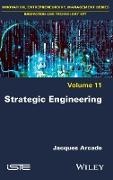Read more
In the face of increasing complexity, uncertainty and difficulty in the design and implementation of reforms, companies, organizations and institutions must strive to capitalize on the prevailing disarray by acting wisely in overcoming it.
Strategic engineering is part of an integrative, tool-based approach, inspired by the life sciences and ?creative recursion?. This book is structured into three parts, which correspond to the three main phases of the strategic engineering approach: observe and discern; judge and arbitrate; act and intervene. Strategic Engineering has wide appeal, relevant to senior leaders, decisionmakers, managers and practitioners within businesses, government and local authorities. It is also intended for those who wish to develop their capability in anticipatory or transformative management within economic, sociopolitical and strategic contexts.
List of contents
Foreword xi
Introduction xv
Part 1. Observing and Discerning: Contextualizing the Situation and Recommending a Consistent Set of Options 1
Chapter 1. Understanding the Strategic Landscape 3
1.1. Understanding the decision-making situation 4
1.1.1. Identifying the variables and factors that make up the situation 4
1.1.2. Detecting the context of the situation through structural analysis 5
1.2. Representing the context of the action 15
1.2.1. Addressing the situational context through nested frames 16
1.2.2. Conceptualizing the strategic landscape as a system with three macrocomponents 17
1.2.3. Reconstructing the multilevel landscape system 26
1.2.4. Configuring the intervention as a system connected to the landscape 32
1.2.5. Specifying the interactions of the "landscape" and "intervention" systems 32
Chapter 2. Imagining and Directing Plausible Futures 37
2.1. Exploring the future through the use of scenarios 37
2.1.1. Reorienting scenarios as a core element of foresight 38
2.1.2. Building frames or scenario profiles 39
2.1.3. Sketching morphological profiles 43
2.1.4. Adopting a two-step procedure 45
2.2. Reinforcing and fleshing out the scenarios 60
2.2.1. Enriching and completing global scenarios 60
2.2.2. Periodically updating the scenarios 63
2.2.3. Using scenarios for strategic purposes 65
Chapter 3. Developing Relevant Strategic Initiatives 67
3.1. Defining objectives and considering options 67
3.1.1. Specifying and defining the main orientations 68
3.1.2. Drafting consistent action profiles 69
3.1.3. The case of the industrial future of a department in Ile-de-France 72
3.2. Transforming options into project concepts 75
3.2.1. Creating the tree of objectives 75
3.2.2. Detecting the critical conditions for achieving objectives 77
3.2.3. Summarizing each option in the form of a logical framework 80
3.2.4. Aggregating projects into coherent programs 85
3.2.5. Considering the plan as a metaprogram of actions 88
Part 2. Judging and Arbitrating: Evaluating and Reconfiguring Recommendations to Decide on a Successful Intervention 91
Chapter 4. Defining Priorities and Gauging Courses of Action 93
4.1. Clarifying preferences and comparing options 93
4.1.1. Setting up the overall performance appraisal system 95
4.1.2. Structuring and weighting criteria according to their hierarchical breakdown 97
4.1.3. Determining the estimators and scales of appreciation of the options according to the operational criteria 100
4.2. Evaluating options according to the macrocriteria to inform the decision 100
4.2.1. Appreciating congruence with the context of intervention as a springboard for pragmatism 101
4.2.2. Assessing future validity as an indicator of future pluralism 106
4.2.3. Assessing the adequacy of the strategic reference as a guarantee of finalism 111
4.3. Gauging the options according to their propensity to immerse themselves favorably in the strategic landscape: interpreting and appropriating the triad of macrocriteria 113
4.3.1. A subtle mix of key priorities 113
4.3.2. An evolving assessment of the intervention according to the macrocriteria 115
4.3.3. Using fundamentally circumstantial multicriteria assessment 116
Chapter 5. Revealing Areas of Potential and Adopting a Decision-making Logic 119
5.1. Modeling the decision problem and scrutinizing the spaces of freedom and opportunity 119
5.1.
About the author
Jacques Arcade is a statistician-economist and teaches on various Master¿s programmes (Sciences Po Rennes, University Paris Dauphine, University Paris 13 and the IRTS Foundation). He is a chief technical adviser to the United Nations and heads consultancy firms, leading many initiatives for forward-looking thinking and strategic innovation.

